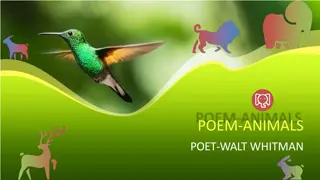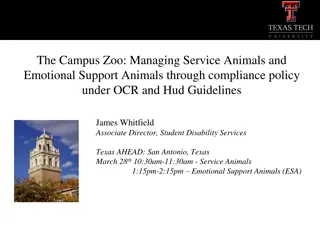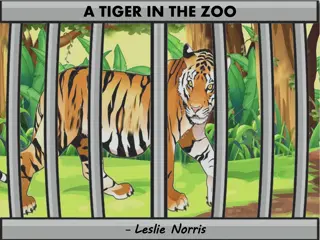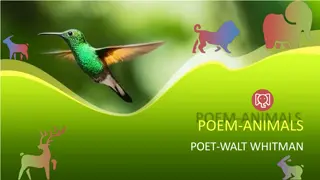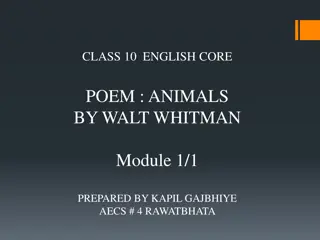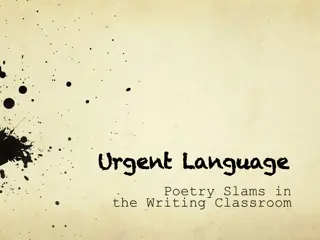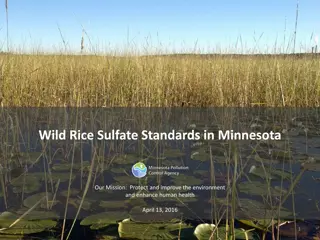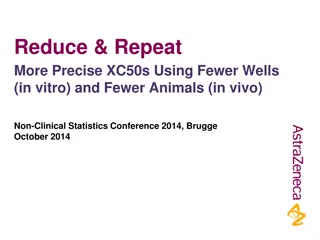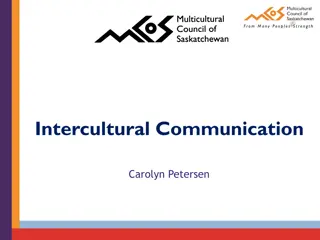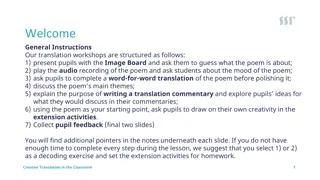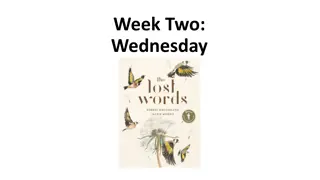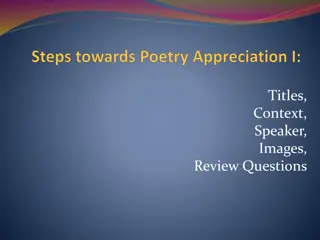Exploring Humorous Techniques in Carolyn Wells' Poem on Wild Animals
The poem by Carolyn Wells humorously depicts the characteristics of wild animals, treating even ferocious beasts with a coat of gentle but weird humor. Through witty language and ironic twists, the poetess describes the different wild animals and their dangerous behaviors, highlighting the risks of being near them. The style is humorous and ironic, with alliteration and poetic license enhancing the poetic effect. The central idea revolves around identifying wild animals and their predatory nature, educating readers on their distinct features.
Download Presentation

Please find below an Image/Link to download the presentation.
The content on the website is provided AS IS for your information and personal use only. It may not be sold, licensed, or shared on other websites without obtaining consent from the author. Download presentation by click this link. If you encounter any issues during the download, it is possible that the publisher has removed the file from their server.
E N D
Presentation Transcript
MODULE 2 HOW TO TELL WILD ANIMALS CAROLYN WELLS
CENTRAL IDEA OF THE POEM The poetess Carolyn Wells, treats even ferocious animals and beasts with a coat of gentle but weird humour. The poem revolves around the different ways to identify the wild animals. These identities are wild in the sense that these wild animals hunt other animals in a dangerous manner. The poetess tries to distinguish one animal from the other in a humorous way. She suggests that it is very risky to be in such proximity to these wild beasts. The poem is, thus very educative as it tells us about various features of wild animals. We come to know how these wild animals behave with their individual features. Carolyn Wells has described the wildlife vividly and in a very lively manner.
HUMOUR IN THE POEM Much of the humour arises from the way language is used. Even the ideas are funny as well. Humour is mild but pungent. It is a very good way of depicting very serious issues in a light-hearted manner. Carolyn Wells creates humour by describing various beasts of prey differently. The poetess treats even ferocious animals and beasts with a coat of gentle but weird humour. The Bengal tiger is noble but eats you . Then the leopard with peppered spots . It is a beautiful looking animal. If an animal eating us has yellow skin and black spots on it, it is Leopard. The seemingly friendly hug of the bear leads to fatal results. The hug will only lead to the death of that person . The crocodiles is weeping while eating its victim and the hyena s merry but weird smile deceive their victims. The hyena looks like as if it is smiling but it is a deception. Both these animals deceive their victim and they attack them.
STYLE The style of the poem is humorous. The use of words and emotions are not only humorous but ironical as well. It is ironical that the noble Bengal Tiger eats you the moment he sees you. The friendly hug of the bear is deadly. The weird but deadly smile of the hyenas and the weeping of crocodiles trap their victims to death. The poem is divided into six stanzas. The rhyme scheme of the stanzas is: ab, ab, cc The poetess takes liberties with the language to create the desired poetic effect. For example, the words lept and lep in the third stanza are deliberately not spelled correctly to create the rhyming effect. And the line, A novice might be nonplus is deliberately written incorrect. It can be correctly written as A novice might be nonplussed . The poet s incorrect lines suit the rhyme scheme of the poem better than the correct version.
Poetic device Alliteration : The occurrence of the same sound at the beginning of adjacent or closely connected words. roaming round Lep and lep again A novice might nonpluss Poetic License: License or liberty taken by a poet in deviating from rule, conventional form, logic or fact, in order to produce a desired effect. As soon as it has lept on you He will only lep and lep again T is the chameleon you see
MULTIPLE CHOICE QUESTIONS 1. Which animal would you find in the jungles of the east? a) Bengal Tiger b) Asian Lion c) Hyena d) Bear
2. Which animal,s roar is enough to kill you? a) Asian Lion b) Leopard c) Bengal Tiger d) Bear
3. Which animal does the poetess refer tocwhen she saysA noble wild beast greets you ? a) Bengal Tiger b) Leopard c) Asian Lion d) Crocodile
4. Who cries while catching its prey? a) Hyena b) Cocodile c) Bear d) Lizard
5. Who smiles while catching its prey? a) Asian Lion b) Hyena c) Crocodile d) None of the above
EXERCISE FOR PRACTICE 1. Does dyin really rhyme with lion ? Can you say it in such a way that it does? 2. How does the poet suggest that you identify the lion and the tiger? When can you do so according to him? 3. Do you think the words lept and lep in the third stanza are spelt correctly? Why does the poet spell them like this? 4. Look at the line A novice might nonplus . How would you write this correctly? Why is the poet s incorrect line better in the poem?
END THANK YOU




